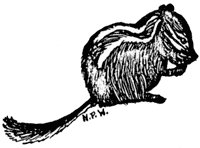Temerity
By Irving E. Blume, Ranger-Naturalist
The golden-mantled ground squirrel is one of Crater Lake National Park’s most interesting smaller mammals, being a constant source of pleasure to all visitors. One of these creatures had the ingenuity to establish his homestead in an obscure hole in the middle of the highway leading to the Rim area from the Park Headquarters. Just as if he were amusing himself at the consternation of the passing motorist, he would sit on his haunches inches from his hole until the automobile was immediately upon him. As the concerned motorist saw the little fellow and attempted to avoid running over him, the little squirrel would dart into the hole with the car only inches away. Many persons got out of their cars and looked in vain for the smallest traffic cop of the Crater Lake highways.
East Entrance Desert Mammals
By Dr. R. R. Huestis, Ranger-Naturalist
During the latter part of the 1941 season, an investigation was made of the mammalian fauna along the East Entrance highway from the park boundary to the south-east margin of Dutton Ridge. Both sides of the highway were set with live traps for a distance of a little over three miles. Only small mammals can enter these traps of these four species were represented: Klamath chipmunk (Eutamias amoenus amoenus), Sierra least weasel (Mustela cicoquanii muricus), Gambel’s deer mouse (Peromyscus maniculatus gambelii) and Coues’ pocket mouse (Perognathus parvus mollipilosus). This last species had not previously been reported from Crater Lake National Park or any part of Oregon north of Fort Klamath. It is associated with relatively arid territory of north-east California and its presence in a forest-covered region within the park boundary is of interest. The deer mice taken along the rims of Wheeler and Sand Creek canyons are in type more like the Sonoran deer mouse than deer mice taken elsewhere in the park.
Coues’ Pocket Mouse: Three female Perognathus were taken along the rim of Wheeler Creek canyon. One, the largest was lactating and also pregnant. It contained six embryos four in one uterine horn and two in the other. One female was pregnant only and contained for embryos two in each horn. The smallest female was neither lactating nor pregnant and may not be within the limits of adult size. The measurements in millimeters are as follows:
| Body | Tail | Tail % | Foot | Ear |
| 70.0 | 85.0 | 121.4 | 22.5 | 8.2 |
| 67.4 | 82.2 | 122.0 | 22.5 | 8.1 |
| 60.2 | 82.6 | 137.2 | 22.6 | 8.0 |
From the measurements it may be seen that these mice are small bodied and long tailed with relatively large feet and small ears. All these mice are smaller than the species’ average recorded by Vernon Bailey for the state but the beginning of at least a second brood in one female would make it seem probable that she was fully adult.
Gambel’s Deer Mice: Twelve deer mice were taken along the highway between the East Entrance and the Lost Creek Ranger Station. Seven, of which six were females, proved to have a body length of 85.0 mm or more and may be considered adult enough for statistical purposes. Most of them were young adults so the average body length is small. Fourteen mice were taken on Dutton Ridge along the East Entrance highway. Ten of these proved to have a body length of 85.0 mm or more. This group was also composed of young adults. The data follows:
| Body Length | |||
| Class (in mm) | East Entrance | Dutton Ridge | Both |
| 85 | 2 | 3 | 5 |
| 88 | 2 | 5 | 7 |
| 91 | 1 | 2 | 3 |
| 94 | 2 | – | 2 |
| 7 | 10 | 17 | |
| Means: | 82.29 +/- 1.33 | 87.70 +/- .85 | 88.35 +/- .70 |
| Std. Dev.: | 3.52 +/0 .94 | 2.10 +/- .46 | 2.88 +/- .49 |
All means are below 90.0 mm the usual figure for large samples of Peromyscusincluding older mice.
| Tail Percentage | |||
| Class (in mm) | East Entrance | Dutton Ridge | Both |
| 76 | 2 | 3 | 5 |
| 79 | 1 | – | 1 |
| 82 | 2 | 3 | 5 |
| 85 | 1 | 1 | 2 |
| 88 | – | 2 | 2 |
| 91 | 1 | 1 | 2 |
| 7 | 10 | 17 | |
| Means: | 80.71 +/- 2.00 | 82.60 +/- 1.61 | 82.18 +/- 1.24 |
| Std. Dev.: | 5.29 +/- 1.40 | 5.16 +/- 1.13 | 5.10 +/- .87 |
| Comparisons of Means | ||
| Crater Lake Rim | 89.6 | .59 |
| Crater Lake South Entrance | 86.1 | .85 |
| Dutton Ridge | 82.6 | 1.61 |
| Dutton and East Entrance | 82.2 | 1.24 |
| East Entrance | 80.7 | 2.00 |
It may bee seen that mice from the southeastern side of the park have considerably shorter tails than mice taken elsewhere. The fact that they are rather small mice minimizes the differences for smaller Peromyscus have relatively longer tails than larger ones.
The differences between the rim and east entrance samples is 8.9 +/- 2.08 per cent and therefore more than four times its standard error. The difference in tail percentage between the Rim sample and the combined Dutton Ridge and east entrance sample of 17 mice is 7.4 +/- 1.37 percent. This difference is more than five times its standard error. Smaller differences are present between mice from the east and south portions of the park in tail percentages but they are still more than twice their standard errors and so of statistical significance.


